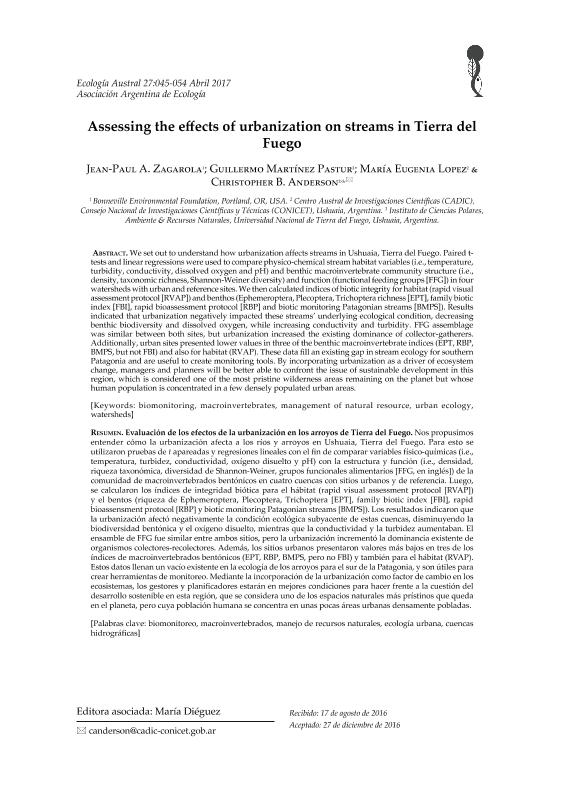Mostrar el registro sencillo del ítem
dc.contributor.author
Zagarola, Jean Paul A.
dc.contributor.author
Martínez Pastur, Guillermo José

dc.contributor.author
Lopez, María Eugenia

dc.contributor.author
Anderson, Christopher Brian

dc.date.available
2018-11-01T13:12:38Z
dc.date.issued
2017-04
dc.identifier.citation
Zagarola, Jean Paul A.; Martínez Pastur, Guillermo José; Lopez, María Eugenia; Anderson, Christopher Brian; Assessing the effects of urbanization on streams in Tierra del Fuego; Asociación Argentina de Ecología; Ecología Austral; 27; 1; 4-2017; 45-54
dc.identifier.issn
0327-5477
dc.identifier.uri
http://hdl.handle.net/11336/63418
dc.description.abstract
We set out to understand how urbanization affects streams in Ushuaia, Tierra del Fuego. Paired ttestsand linear regressions were used to compare physico-chemical stream habitat variables (i.e., temperature,turbidity, conductivity, dissolved oxygen and pH) and benthic macroinvertebrate community structure (i.e.,density, taxonomic richness, Shannon-Weiner diversity) and function (functional feeding groups [FFG]) in fourwatersheds with urban and reference sites. We then calculated indices of biotic integrity for habitat (rapid visualassessment protocol [RVAP]) and benthos (Ephemeroptera, Plecoptera, Trichoptera richness [EPT], family bioticindex [FBI], rapid bioassessment protocol [RBP] and biotic monitoring Patagonian streams [BMPS]). Resultsindicated that urbanization negatively impacted these streams? underlying ecological condition, decreasingbenthic biodiversity and dissolved oxygen, while increasing conductivity and turbidity. FFG assemblagewas similar between both sites, but urbanization increased the existing dominance of collector-gatherers.Additionally, urban sites presented lower values in three of the benthic macroinvertebrate indices (EPT, RBP,BMPS, but not FBI) and also for habitat (RVAP). These data fill an existing gap in stream ecology for southernPatagonia and are useful to create monitoring tools. By incorporating urbanization as a driver of ecosystemchange, managers and planners will be better able to confront the issue of sustainable development in thisregion, which is considered one of the most pristine wilderness areas remaining on the planet but whosehuman population is concentrated in a few densely populated urban areas.
dc.format
application/pdf
dc.language.iso
eng
dc.publisher
Asociación Argentina de Ecología

dc.rights
info:eu-repo/semantics/openAccess
dc.rights.uri
https://creativecommons.org/licenses/by-nc-sa/2.5/ar/
dc.subject
Biomonitoreo
dc.subject
Macroinvertebrados
dc.subject
Manejo Recursos Naturales
dc.subject
Ecología Urbana
dc.subject
Cuencas Hidrográficas
dc.subject.classification
Otras Ciencias Biológicas

dc.subject.classification
Ciencias Biológicas

dc.subject.classification
CIENCIAS NATURALES Y EXACTAS

dc.title
Assessing the effects of urbanization on streams in Tierra del Fuego
dc.title
Evaluación de los efectos de la urbanización en los arroyos de Tierra del Fuego
dc.type
info:eu-repo/semantics/article
dc.type
info:ar-repo/semantics/artículo
dc.type
info:eu-repo/semantics/publishedVersion
dc.date.updated
2018-10-19T15:04:52Z
dc.journal.volume
27
dc.journal.number
1
dc.journal.pagination
45-54
dc.journal.pais
Argentina

dc.journal.ciudad
Buenos Aires
dc.description.fil
Fil: Zagarola, Jean Paul A.. Bonneville Environmental Foundation; Estados Unidos
dc.description.fil
Fil: Martínez Pastur, Guillermo José. Consejo Nacional de Investigaciones Científicas y Técnicas. Centro Austral de Investigaciones Científicas; Argentina
dc.description.fil
Fil: Lopez, María Eugenia. Consejo Nacional de Investigaciones Científicas y Técnicas. Centro Austral de Investigaciones Científicas; Argentina
dc.description.fil
Fil: Anderson, Christopher Brian. Consejo Nacional de Investigaciones Científicas y Técnicas. Centro Austral de Investigaciones Científicas; Argentina
dc.journal.title
Ecología Austral

dc.relation.alternativeid
info:eu-repo/semantics/altIdentifier/url/http://ojs.ecologiaaustral.com.ar/index.php/Ecologia_Austral/article/viewFile/417
Archivos asociados
